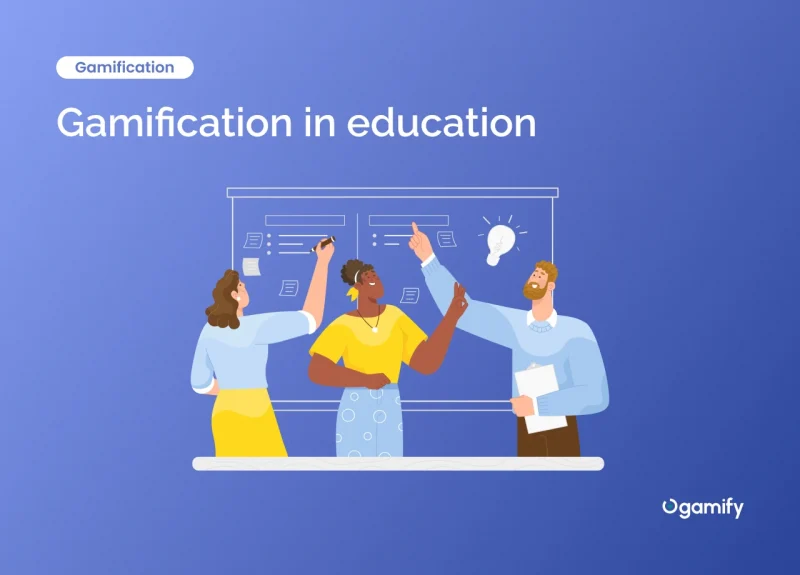Learning can be fun, engaging, and effective when gamification techniques are utilized. From fun learning games for kids to custom gamification in online learning for adults, the benefits of incorporating gamification in education are numerous.
In this article, we explore what is gamification in learning and education, provide examples of its application in various contexts, and discuss the challenges of introducing gamification in adult education. Additionally, we emphasize the value of gamification in adult learning and its engaging potential.
Reasons for lack of motivation to learn in adults
Many adults often struggle with finding the motivation to learn new skills or knowledge. One of the most common reasons is the lack of time due to other commitments such as work or family responsibilities. This can lead to a sense of overwhelm and make it difficult to prioritize the boring work which is learning.
Low self-esteem can also be a major hurdle for adults seeking to learn new things. They may feel inadequate or unsure of their abilities, which can create a sense of fear or anxiety around learning. By creating a supportive learning environment that builds confidence and self-assurance, we can help adults overcome their fears and achieve their goals.
Disinterest is a pervasive and often overlooked factor contributing to a lack of motivation in adults regarding learning. When the subject matter feels dry or unengaging, it can be difficult to maintain focus and enthusiasm, leading to a sense of apathy and disconnection from the learning process. This disinterest in the material can be compounded by a lack of understanding about how the knowledge or skills will apply to one’s life, further eroding motivation and making it challenging to stay committed to the learning process.
Another strategy is to connect the studying to real-life situations or personal interests. For example, someone learning a new language could target vocabulary related to their favourite hobbies or travel destinations. Adults can overcome common barriers to amplify their incentive and succeed in their learning endeavours by making it more relevant and enjoyable.
How gamification can help engage adults in the learning process
Gamification can be an effective method to involve adults in the learning process. It uses game-based learning elements to make it fun, interactive, and engaging. Educators can amplify incentives and commitment among their students by incorporating the definition of gamification in learning. This is because gamification creates a sense of competition and achievement, which drives learners to put in more effort to achieve their goals.
Furthermore, gamification can facilitate knowledge acquisition by breaking complex concepts into smaller, more manageable tasks. This enables learners to grasp difficult concepts more easily, as they can focus on one aspect of the learning procedure at a time.
Moreover, gamification can improve academic performance by making learning more interactive and engaging. This is because learners are more likely to retain information that is presented in a fun and interactive manner, and they are also to stay engaged in the learning activity for longer periods of time.
Finally, gamification can also help with skills development. By incorporating game-like elements such as challenges and rewards, learners can develop important skills such as problem-solving, critical thinking, and decision-making. This is because gamification provides learners a safe and supportive environment to practice these skills without fearing failure or judgment.
What methods to use to gamify the learning process for adults

Gamification is an influential tool to enhance the learning experience, especially for adults. Several aspects of gamification in learning and development can be used to make it more engaging and effective. One key method is introducing rewards and challenges to motivate learners to complete tasks and achieve objectives. This approach creates a sense of achievement and provides instant feedback that encourages learners to continue their progress.
Another method is accelerated learning, which involves creating a sense of urgency and making learning more exciting by setting time limits, using visuals, and incorporating bilateral elements. By making the learning experience more interactive, immersive, and enjoyable, accelerated learning can increase motivation, improve retention, and help learners achieve their goals more quickly and efficiently.
Games and activities are another effective way to gamify adult learning tasks. Games provide a fun and engaging way to learn new concepts and reinforce existing knowledge. By incorporating games and activities, learners can test their knowledge and skills while having fun.
Personalization of the learning procedure is also critical in gamification. By tailoring the learning experience to the individual needs of learners, it becomes more relevant and meaningful to them. Personalization can be achieved through adaptive learning technologies or by giving learners choices in their learning journey.
To sum up, gamification is a powerful way to make learning more engaging and effective for adults. Aspects such as rewards and challenges, accelerated learning, games and activities, and personalization are all critical elements to incorporate into the process. These methods motivate learners to learn faster, retain more knowledge, and apply their skills in real-life situations.
Benefits of gamification in learning

Gamification in eLearning and Learning has become increasingly popular in recent years, and with good reason. The benefits of incorporating game components into those activities are numerous and significant.
One of the primary advantages of gamification in virtual learning is enhanced engagement and motivation. When learners actively engage in learning, they are more likely to absorb and retain the information presented. This increased engagement and incentive can lead to improved learning outcomes, as learners are more invested in the material and more likely to put forth the effort required to master it.
Another significant benefit of gamification in eLearning is the development of valuable skills. Games templates are designed to challenge players and require them to develop problem-solving, critical thinking, and decision-making skills. When these elements are incorporated, learners can develop these skills pleasingly and engagingly.
Additionally, rewards and recognition can further incentivize learners to work towards achieving their learning goals. Gamification in eLearning also creates a challenging learning environment. By incorporating elements such as competition, timed challenges, and point systems, learners are encouraged to push themselves beyond their comfort zones and strive for excellence. This challenging environment can lead to accelerated learning, as learners are motivated to achieve mastery of the material.
In summary, the benefits of gamification for students are numerous and significant. Enhanced engagement and motivation, improved learning outcomes, development of valuable skills, rewards and recognition, a challenging learning environment, and accelerated learning are just a few advantages of incorporating game elements into the learning process. By embracing gamification, learners can enjoy a more engaging, rewarding, and effective experience.
Examples of using gamification in adult education

Gamification has become increasingly popular in the field of adult education, especially when it comes to foreign language learning. Many digital platforms have found innovative ways to incorporate gamification elements into their language learning programs, making the process more engaging for learners. Kahoot, Memrise, Duolingo, and Quizlet are popular fun learning websites and apps used in adult teaching today.
Kahoot is a platform that allows educators to create quizzes and games for their online students. The quizzes can be customized to suit the needs of learners and can include images, videos, and other multimedia components. This interactive approach to learning has proven to be highly effective in keeping learners engaged and motivated.
Memrise is another gamification tool that uses various learning techniques such as gamification, spaced repetition, and mnemonics to help learners remember foreign language vocabulary. This platform offers a range of courses in different languages and levels, catering to learners of all proficiency levels.
Duolingo is one of the most popular gamification tools for foreign language learning. The app offers a range of language courses designed to be fun and engaging while being highly effective. The platform uses a variety of gamification mechanisms, such as rewards, leaderboards, and badges, to incentivize learners to continue practising.
Quizlet is a digital study tool that uses gamification to help learners practice and remember foreign language vocabulary. The platform offers a range of study modes, including flashcards, quizzes, and games, designed to make learning pleasing and engaging.
Overall, gamification in foreign language learning has proven to be a highly effective tool. These platforms offer a fun and bilateral approach that keeps learners engaged and motivated throughout the process and show us the essential role of gamification in online learning.
What challenges arise when introducing gamification in adult education?

While gamification has gained significant attention in the education industry, some argue against the future use of gamification in the classroom. These sceptics believe that games are for entertainment and do not serve any educational value. However, research has shown that gamification can effectively engage adult learning and improve outcomes. That being said, it is important to acknowledge the challenges that arise when introducing gamification in adult education.
One of the biggest challenges is adapting games to the needs of adult participants. Unlike children, adults have different learning styles and preferences, and not all games may suit them. Therefore, choosing games that align with adult learners’ learning objectives and preferences is crucial.
Another objection is gaining support from employers and educational institutions. Some employers and institutions may not see the value of gamification in learning, making it difficult to implement such programs. Therefore, it is important to communicate the benefits of gamification in schools to these stakeholders and demonstrate how it can improve employee or student engagement and performance.
Choosing the right tools for efficiency and platforms can also be challenging. Many gamification platforms are available in the market, each with its own strengths and weaknesses. It is important to evaluate these platforms based on factors such as ease of use, customization options, and analytics capabilities to ensure that they meet the needs of adult learners.
In conclusion, while some argue against using gamification in learning, it can effectively engage adult learners and improve learning outcomes. However, it is important to acknowledge the challenges and address them proactively to ensure that gamification is implemented successfully in adult education.
What additional ways can be used to motivate adults to learn?

Learning can be daunting, especially for adults who have already established their daily routines and busy lives. However, there are several ways to make learning engaging for them.
One of the ways is to link science with interesting hobbies and interests. For example, an adult is interested in cooking can learn about the science behind cooking, such as how different ingredients react. This not only causes that learning is fun but also helps them apply their newfound knowledge to their hobbies and interests.
Another way to motivate adults to learn is to find ways to put the acquired knowledge into practice. For instance, if they are learning a new language, they can practice speaking with native speakers or watch movies in that language. This helps to reinforce their learning and make it more meaningful.
Creating learning groups and communities is also an effective way to make learning fun for adults. Being part of a group with similar interests and goals can provide a supportive and encouraging environment. They can exchange ideas, share resources, and provide feedback to one another, making the learning process more interactive and collaborative.
In conclusion, making learning entertainment for adults requires creativity, relevance, and engagement. Linking science with interesting hobbies and interests, finding ways to put the acquired knowledge into practice, and creating learning groups and communities are just a few of the many ways to make learning an enjoyable and rewarding experience.
Conclusion
Implementing gamification in teaching and learning has surfaced as a potent tool to enrich the adult learning encounter. It is a technique that involves using game-based elements to make learning more fun, interactive, and engaging. Gamification can facilitate knowledge acquisition, improve academic performance, and help with skills development.
Methods such as rewards and challenges, accelerated learning, games and activities, and personalization are critical elements to incorporate into the process. The benefits of gamification in the classroom include enhanced engagement and motivation, developing valuable skills, and using rewards and recognition to incentivize learners. Overall, gamification can revolutionise how we approach adult learning and schooling and engage lifelong learners.
FAQ
Can adults learn effectively through online platforms?
Yes, online platforms can be highly effective for adult learning. Online courses, webinars, or e-learning platforms provide flexibility, accessibility, and a wide range of resources. Adults can learn at their own pace and engage in interactive online communities for support and collaboration.
How can adult learners overcome the fear of failure or making mistakes?
It’s important to create a safe and non-judgmental learning environment for adult learners. Encourage a growth mindset that embraces mistakes as learning opportunities. Foster a culture where mistakes are seen as stepping stones toward improvement and provide constructive feedback that encourages resilience and continuous learning.
What if adults have limited time for learning due to other commitments?
Recognize that adults often have busy lives with various commitments. Provide flexible learning options, such as microlearning modules or short sessions, that can be easily integrated into their schedules. Emphasize the value of consistent, small steps toward learning rather than overwhelming time demands.
How can adult learners stay motivated throughout their learning journey?
Motivation can be sustained by celebrating milestones and achievements, providing ongoing feedback and support, and ensuring the learning content remains relevant and engaging. Incorporating elements of choice and autonomy in the learning process also fosters motivation and a sense of ownership.


